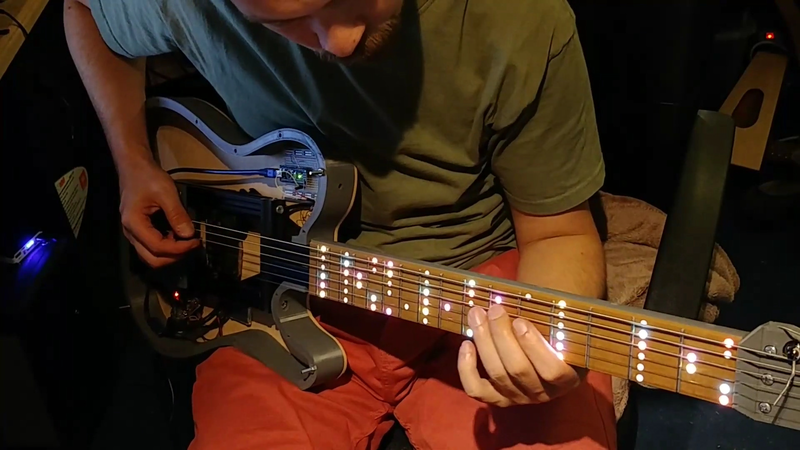We just wrapped up the Musical Instrument Challenge in the Hackaday Prize, and that means we’re sorting through a ton of inventive electronic musical instruments. For whatever reason we can’t seem to find many non-electronic instruments. Yes, MPCs are cool, but so are strings and vibrating columns of air. That’s what makes this entry special: it’s a 3D printed physical guitar. But it’s also got a hexaphonic pickup, there are lights in the fretboard, and it talks to a computer for PureData processing.
First, the construction of this guitar. It’s mostly 3D printed, with the ‘frame’ of the body made in a Creality 3D printer. It’s a bolt-on neck with a telecaster body, but the core of this guitar — where the pickups and bridge attach — are made out of aluminum extrusion. Another piece of aluminum extrusion runs down the neck, which is clad in a 3D-printed ‘back’ that looks ‘comfortable enough’. The headstock is bolted onto the end of this neck, and it seems reasonably tolerant of having a hundred pounds or so of strings pulling on it. The bridge is also 3D printed, with the saddles integrated into the print. Conventional wisdom says this would sound terrible, but nylon saddles were a thing back in the day, so we’re just going to roll with it.
The electronics are where this project really shines. The pickup is a salvaged Roland GK3 hexaphonic deal, with six outputs for each string. This is sent into a Teensy with an audio path for each individual string. Audio processing happens in the guitar, and latency is under five milliseconds, which is quick enough to not be a terrible distraction.
Except for synths and drum machines and computers, the last fifty or so years of technological progress hasn’t really made it to the world of musical instruments. Guitarists, especially, are technophobes who hate everything invented after 1963. While the neck of [Frank]’s ElektroCaster probably doesn’t feel great, this is a really interesting instrument and a great entry to the Hackaday Prize.



















Here’s the link: https://hackaday.io/project/161675-elektrocaster
Thanks. This project definitely deserves a better than shoddy article, the author did not even go through the project gallery, and overlooked the nice features of this guitar. Got to watch the “string sequencing” video !
This could be made into a Moog style self sustaining guitar with six amps and six put-downs. A put-down is the opposite of a pick-up, by feeding back signal into the string via the put-down the string will vibrate by it’s self.
I have tested pickups small enough to lay 6 together for your design. No deed for the exotic part. They are just the little beepers without the metal cover found in so much computer junk, modem cards etc. A perfect pot coil and magnet. The problem is when used as put-downs, the coil is a fairly high impedance. Low is easier to drive with a little low voltage amp. If the pick-up and the put-down are too close together they will squeal instead of work right. This will limit the range of the high notes. I use a contact mic pick-up and coil put-down and get the best range and lack of magnetic feedback. This only works for one or two strings, but very well.
Slide meets Theremin.
I’m working on something similar and was thinking of using a full guitar pickup for each string (as low as 3$ each and I’m not space constrained), Thanks for the alternative option.
Hah, I’ve been kicking around the same idea on paper ever since I saw the Moog guitar. I was taking it in a slightly different direction where a processor generates the feedback signal to provide more harmonic control and maybe even VCA.
This guy wins, time to rap it up. That build is beyond believable.